Working in a Shared Review task as a lead assignee
Review tasks allow you to inspect an item list on an item-by-item basis. As a lead assignee, you can count assignees’ votes on each item, edit items in the task, and read comments to make a final decision and change the item’s workflow status. In a Shared Review task, all assignees work on the same copy of the item.

This article explains how to work in a Shared Review task as a lead assignee, including how to make final decisions on items.
In this article
1. Open the task
On the Tasks list, select the Review task you want to work on. The task details panel displays the task’s description and doughnut charts representing the number of submitted items and days until the deadline. You can also download attachments if the task has any. For more information, read About the Tasks screen.

Select Open Task to open the Item Review screen and start working on the Review task. This changes the task’s status to In progress.

2. Preview an item
The Item Review screen contains all items in the associated item list. Items are displayed in the test driver, allowing you to see the items from a candidate’s perspective.
Use the item information panel to view the item’s settings.
| Icon | Setting | Description |
|---|---|---|
| Item Settings |
View information about Item Version, Item Purpose, Marking Type, Mark, and Correct Answer. |
|
| Item Tags |
View the item’s assigned tag groups and tag values. For more information, see Using tags in items. |
|
| Item Tag Collections |
View the item’s assigned tag collections. For more information, read Using tag collections in items. |
|
| Item Enemies |
View any enemy items associated with the item. For more information, see Adding enemies to an item. |
|
| Citations |
View the item’s citations. For more information, see Adding citations to an item. |
|
| Comments |
View the item’s comments. Public Comments are item comments and Task Comments are comments left by other assignees within the task. For more information, see Leaving comments on items. |
|
| Candidate Feedback |
View the correct answer and any candidate feedback that has been added to the item. For more information, see Adding candidate feedback to items.
NOTE: Correct answer may not always show as it depends on the item type.
|
Select Undock to pop out the dialog windows for any information available in the panel. Select and drag the dialog window to move it around the screen.

Select Dock to return the dialog window to the right-hand side panel.

Select an item breadcrumb on the item navigation panel to go to another item.
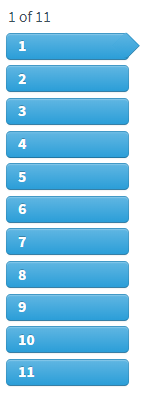
Alternatively, you can enter a specific item number into the Go to item field to navigate directly to that item.
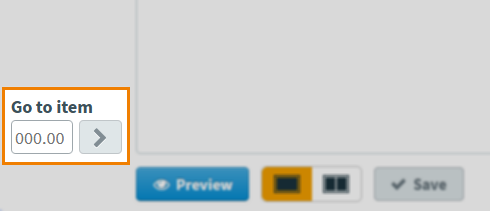
If an item is in an item set, you can enter a decimal (such as 1.3) in the Go to item field to navigate directly to that item.

You can also select Previous and Next to move through the item list.

Flagging items
You can flag items to mark them for an action at a later time. As lead assignee, you can see all assignees’ flagged items.
Exporting task items
As lead assignee, you can export the task items to analyse them in further detail. For further information, read Downloading Review task reports and Exporting Review task items.
3. Edit the item
You can amend items from the Item Review screen. Select Edit Item to go to the Edit screen.

You can edit question stems, answer options, media, tools, and item settings. For more information on editing items, read Creating items.
After saving the item, your changes are reflected in Item Authoring. However, the item will be locked for editing until you or a manager finalise the task.
About tracked changes
Task managers can enable tracked changes at the task creation stage to record certain text edits made to items as part of the task. Additions and deletions are colour-coded by user and tracked in question stems, answer options, and the Candidate Feedback field.
As a lead assignee, you can accept or reject changes.
Duplicating items
Lead assignees can duplicate existing items in a Review task.
4. Review vote results
In Shared Review tasks, assignees vote on the quality of items. There are three vote types:
Reject votes are for poor items that do not meet the standards for testing.
Advise votes are for items that will be suitable for testing after minor amendments, but are not satisfactory in their current state.
Approve votes are for items that need no corrections.
As lead assignee, you have the ability to tally all assignees’ votes. Assignees’ votes are represented as a bar chart on each item in the Item Review screen. Hover over each segment of the chart to reveal more information.

Select Comments to open the Review Comments dialog and see the comments assignees left when they voted on the item.

5. Make a final decision
After reviewing assignees’ votes, select Decision to make a final decision on the item and change its workflow status.

In the Decision dialog, select either Reject, Advise, or Approve as your final decision. You do not have to follow the majority of votes.

You can add explanations to your decision in the Comment section. Comments are required when Reject or Advise is selected. Comments are optional when Approve is selected. This explanation is saved as a comment against the item and is visible in Item Authoring. For more information, read Leaving comments on items.
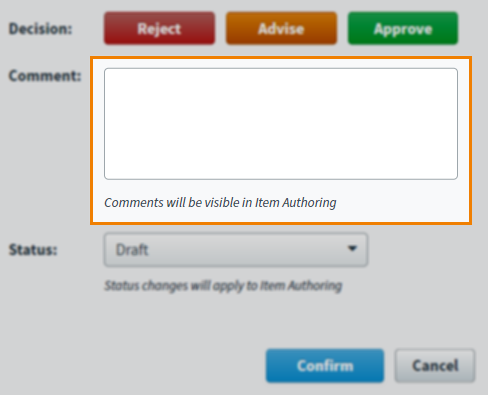
Finally, use the Status menu to choose a new workflow status for the item.
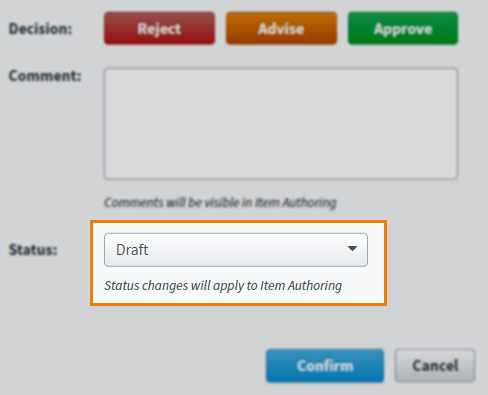
Select Confirm when done to submit your final decision.
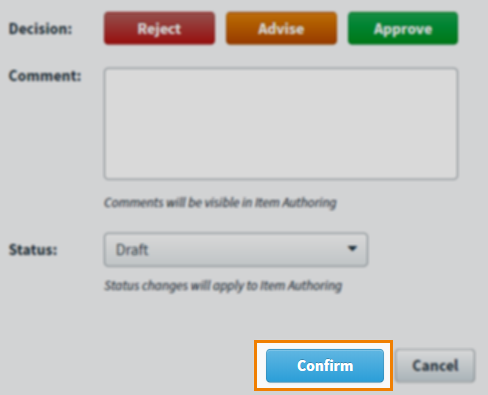
Your decision is now visible on the Item Review screen.

6. Close the task
After making a final decision on all items, you can close the Review task.
Select Return to Tasks to close the task and return to the Tasks screen.

7. Finalise the task
Select Finalise Task in the task details panel when you are satisfied that the task is complete.

This changes the task’s status to Complete.
Marking a task as incomplete
You can mark a task as incomplete if you incorrectly select Finalise Task or the task needs to be reopened for further work.
Further reading
For more information on Review tasks, or working in other task types as a lead assignee, read the following articles:
- About task types
- About the Tasks screen
- About task managers, assignees, and lead assignees
- Working in an Authoring (Edit Existing Items) task as a lead assignee
- Working in an Authoring (Create New Items) task as a lead assignee
- Working in an Individual Review task as a lead assignee
- Working in an Item Analysis Review task as a lead assignee
- Working in a Standard Setting task as a lead assignee















